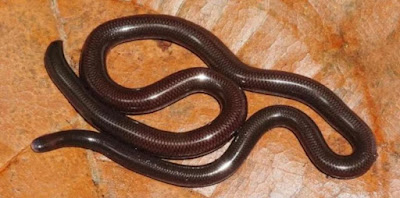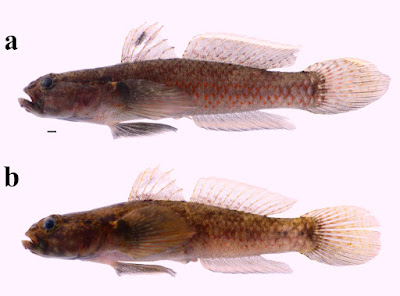[Most Recent Entries] [Calendar View]
Saturday, December 14th, 2024
| Time | Event | ||||
| 1:09p | [Botany • 2022] Allium sulaimanicum (Amaryllidaceae) • A new Allium species and section from Pakistan
A new species, Allium sulaimanicum, is described from northern Balochistan and southern Khyber Pakhtunkhwa in Pakistan based on morphological, molecular, and cytological studies. The new species is characterised by long runner-like cylindrical rhizomes of adult plants, cylindrical bulbs, linear leaves with minute soft hairs along veins, campanulate perigonium, and white to creamy white, ovate to elliptical, 4.5–5-mm-long acute tepals, with brownish to purplish nerves, stamens as long as to slightly longer than tepals, yellow to brick red anthers, hexagonal ovary, and white and papillate/warty along angles. The presence of long herbaceous rhizomes indicated serious isolation of the new species; hence, a new section Sulaimanicum is proposed to accommodate the new species. The new species is diploid with a chromosome number of 2n = 16. Detailed morphological description, illustrations, phylogenetic analyses based on sequences of plastid spacers (rpl32-trnL (UAG) and trnQ-rps16) and nuclear ITS, karyotype features, and a distribution map of the new species are provided. Nazar Khan, Nikolai Friesen, Amir Sultan, Reinhard M. Fritsch, Tahir Khan and Kamran Ishaq. 2022. Allium sulaimanicum: A new Allium species and section from Pakistan. Front. Plant Sci. 13:1020440. DOI: 10.3389/fpls.2022.1020440 | ||||
| 2:00p | [Botany • 2024] Whittieria hengduanensis (Ophioglossaceae) • A New fern Species from Southwest China demonstrates a unique intercontinental disjunct pattern in plants between the Himalaya and the Americas Abstract A new fern species, Whittieria hengduanensis (Ophioglossaceae), from Sichuan, Xizang, and Yunnan, Southwest China (eastern Himalaya), is described and illustrated. This species is similar to W. engelmannii in the Americas in having a cylindrical rhizome and complex-reticulate venation. In addition, both species grow in open habitat on basic soil. However, the two species are distinguishable in root number per rhizome and the number of the larger areolae per trophophore. Our molecular study also supports that they are sister to each other but divergent at the molecular level. The discovery of W. hengduanensis shows that the genus is intercontinentally disjunct between the Himalaya and the Americas, a unique pattern not having been documented in the literature. Key words: Adder’s tongues, fern biogeography, intercontinental disjunctions
Whittieria hengduanensis Z.L.Liang & Li Bing Zhang, sp. nov. Diagnosis: Whittieria hengduanensis is similar to W. engelmannii but the former has up to 25 (–50) roots per rhizome and 10–20 large areolae per trophophore, whereas the latter has fewer than 15 roots per rhizome and 0–8 areolae per trophophore. Etymology: The species epithet henduanensis is based on the distribution of this species in the Hengduan Mountain. Zhen-Long Liang, Li-Bing Zhang. 2024. Discovery of Whittieria hengduanensis sp. nov. (Ophioglossaceae) from Southwest China demonstrates a unique intercontinental disjunct pattern in plants between the Himalaya and the Americas. PhytoKeys 249: 27-36. DOI: doi.org/10.3897/phytokeys.249.135379 | ||||
| 2:08p | [Herpetology • 2024] Liotyphlops pino • A New Species of the genus Liotyphlops Peters, 1881 (Serpentes: Anomalepididae) from the Caribbean coast of Honduras
Abstract We describe a new species of the genus Liotyphlops from the Caribbean coast of Honduras in Nuclear Mesoamerica, a genus previously known only from Isthmian Mesoamerica and northern, central, and eastern South America. Our description is based on a single specimen found by chance. The new species differs from other congeners by unique combination of external morphological characteristics, specifically by the presence of three scales on the first vertical row of the dorsals, three supralabial scales, 425 dorsal scales, and dorsals in 22 series of uniformly pigmented scales across the body. The type locality represents the northernmost record for the genus and is located 920 km (airline) northwest of the previous record for Liotyphlops albirostris in Costa Rica. We developed an identification key for the genus and discussed natural history and biogeographical aspects of Liotyphlops, including the species described here. Reptilia, Distribution, external morphology, fossorial snakes, Pico Bonito National Park, species diversity Cristopher A. Antúnez-Fonseca, Josue Ramos-Galdámez, José Mario Solís, Juan C. Díaz-Ricaurte and Larry David Wilson. 2024. A New Species of the genus Liotyphlops Peters, 1881 (Serpentes: Anomalepididae) from the Caribbean coast of Honduras. Zootaxa. 5543(1); 97-110. DOI: doi.org/10.11646/zootaxa.5543.1.5 | ||||
| 2:08p | [Botany • 2024] Begonia corazoniae (Begoniaceae, sect. Petermannia) • A New endemic Species from southeastern Mindanao, Philippines
Abstract A new Begonia section Petermannia species, Begonia corazoniae Naive, discovered in the forest ecosystems of Davao Oriental, southeastern Mindanao, Philippines, is herein described and illustrated. It closely resembles B. rieckei, but is easily recognized by having paniculate inflorescences with prominently winged ovary and capsule. A comprehensive morphological description, geographic distribution, ecology, phenology and a discussion of similar species is provided. In addition, we assessed this species as ‘Endangered' (EN B1(iii) + 2(iii)) following the criteria of the IUCN. Keywords: buffer zone, Davao Oriental, endangered, Philippine Begonia, tropical taxonomy Begonia corazoniae Naive Mark Arcebal K. Naive, Milton Norman D. Medina and Jhonnel P. Villegas. 2024. Begonia corazoniae (Begoniaceae, section Petermannia), A New endemic Species from southeastern Mindanao, Philippines. Nordic Journal of Botany. DOI: doi.org/10.1111/njb.04641 x.com/begoniARCIIae/status/1866786807742075034 | ||||
| 2:10p | [Entomology • 2024] Prodasineura sangkhla • A New Damselfly (Odonata: Platycnemididae) from western Thailand
Abstract Prodasineura sangkhla sp. nov. is described from the Takhian Thong waterfall near the Thai-Myanmar border, Kanchanaburi Province, Thailand. It differs from all other species of Prodasineura Cowley, 1934 by the combination of the characters including white pruinescence on prothorax, synthorax and some parts of legs, blue markings on S10 and anal appendages, shape of anal appendages in males, and shape of occipital band and posterior process of posterior lobe in females. Odonata, dragonfly, Zygoptera, new species, morphology Prodasineura sangkhla sp. nov. Tosaphol Saetung Keetapithchayakul, Noppadon Makbun, Kaewpawika Jitthamma Ignatius, Quoc Toan Phan. 2024. Prodasineura sangkhla sp. nov., A New Damselfly from western Thailand (Odonata: Platycnemididae). Zootaxa. 5551(1); 131-140. DOI: doi.org/10.11646/zootaxa.5551.1.5 [News] แมลงปอเข็มท้องเข็มสังขละ (Prodasineura sangkhla) แมลงปอชนิดใหม่ชนิดแรกและชนิดส่งท้ายปี 2024 แมลงปอเข็มท้องเข็มสังขละได้รับการบรรยายเ คณะผู้บรรยายค้นพบแมลงปอเข็มชนิดนี้พร้อม ๆ กับแมลงปอเข็มท้องเข็มชนิดอื่น ๆ อีก 3 ชนิดคือ แมลงปอเข็มท้องเข็มดำ (Prodasineura autumnalis) แมลงปอเข็มท้องเข็มเอราวัณ (P. laidlawii) และแมลงปอเข็มท้องเข็มเสี้ยวส้ม ฟอร์มตะวันตก (P. sp. [nec. verticalis]) แต่ด้วยลักษณะอันโดดเด่นของตัวผู้ ทำให้เราแยกแมลงปอเข็มท้องเข็มสังขละได้ไม แมลงปอเข็มชนิดนี้พบเกาะตามปลายใบไม้และกิ --- A new species of genus Prodasineura, P. sangkhla, was described from Sangkhla Buri, Kanchanaburi Province. The description was published in Zootaxa today. This new species co-occurs with other three members of the genus, that is P. autumnalis, P. laidlawii and P. sp. [nec. verticalis]. With white pruinosed thorax and blue abdomenal tip, males of P. sangkhla is easily differentiated from those species. Unlike the males, the general appearance of the females are similar to the congeners found in the area but you need to look at shape of prothorax and number of ventral spine on cerci for making an accurate ID. Prodasineura sangkhla was spotted perching on leaf or twig along the stream in Sangkhla, Kanchanaburi Province and expected to be found in nearby area in Myanmar. | ||||
| 2:10p | [Botany • 2024] Pleurothallis cop-biodiversitatis (Orchidaceae: Pleurothallidinae) • A New Species from Colombia
Abstract A new species, Pleurothallis cop-biodiversitatis, belonging to Pleurothallis subsection Macrophyllae-Fasciculatae, from the Central Andes of Colombia, is described and illustrated. This new species is compared with Pleurothallis matudana and Pleurothallis tandapiensis, the most morphologically similar species. Pleurothallis cop-biodiversitatis primarily differs from these species in having a lip with erose margins, more pronounced basal lobes, a rounded, apiculate apex, and a sulcate blade with a lanceolate, strongly vesiculate concavity. Keywords: Andean Orchids, COP 16, Epidendreae, Macrophyllae-Fasciculatae, Pleurothallis matudana, Pleurothallis tandapiensis, Tolima, COP16
Pleurothallis cop-biodiversitatis Sierra-Ariza sp. nov. TYPE: COLOMBIA. Tolima: Municipio de Cajamarca, vereda Bolívar, 2690 m, 13 April 2022, M. A. Sierra-Ariza & J.C. Pavas 429 (holotype: TOLI). Diagnois: Species similar to Pleurothallis matudana C.Schweinf., but distinguished by the lip with erose margins, more pronounced basal lobes, rounded apex, and longitudinally sulcate with a lanceolate, strongly vesiculose basal concavity. Mario Alexei Sierra-Ariza. 2024. Pleurothallis cop-biodiversitatis (Pleurothallidinae), A New Species from Colombia. LANKESTERIANA. 24(3); 259–265. DOI: doi.org/10.15517/lank.v24i3.61038 ???? ¡Increíbles noticias desde la COP16!???? ????✨ - ???? Pleurothallis petroana, en honor a nuestro presidente Gustavo Petro - ???? Pleurothallis franciana, en homenaje a nuestra vicepresidenta Francia Márquez - ???? Malaxis susanae, en reconocimiento a nuestra Ministra de Ambiente y Desarrollo Sostenible, Susana Muhamad Además, la cuarta especie, Pleurothallis cop-biodiversitatis, fue nombrada en conmemoración de la histórica #COP16 celebrada en Cali en 2024. ????✨ | ||||
| 2:11p | [Ichthyology • 2024] Drombus rubropunctatus • A New brackish Goby of Drombus (Teleostei: Gobiidae) from Taiwan with short comments on related gobiid species
Abstract The brackish environments of Taiwan were relatively unexplored and therefore houses many cryptic fish species, some of which were still unknown to science till this day. After our repeated estuarine surveys and collections, it was encountered an undescribed species of genus Drombus, that can be clearly separated from its congeners by the following unique combinations of characters: (a) dorsal fin elements VI-I, 10; anal fin elements I, 9; pectoral fin elements modally 17; (b) longitudinal scale rows 32–34; transverse scale rows modally 13; predorsal scale rows 9–10; and (c) specific coloration: body brownish with dark red spots scattered; first dorsal fin dusky with a black blotch. The brief morphological comparisons of the new species with its congeners is also provided herein. Pisces, taxonomy, new species, estuary, Drombus, Gobiidae
Drombus rubropunctatus Chen & Li, new species I-Shiung CHEN and Hsien-En LI. 2024. A New brackish Goby of Drombus (Teleostei: Gobiidae) from Taiwan with short comments on related gobiid species. Zootaxa. 5550(1); 224-234. DOI: doi.org/10.11646/zootaxa.5550.1.22 |
| << Previous Day |
2024/12/14 [Calendar] |
Next Day >> |
























